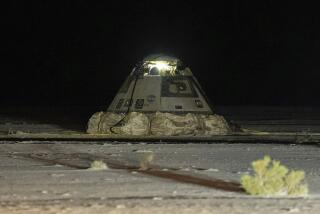Crew on Edge During Reentry
- Share via
EDWARDS AIR FORCE BASE — Once they were safely on the ground, the seven astronauts of the shuttle Discovery acknowledged some tense moments as they prepared to reenter Earth’s atmosphere.
Their worry grew as shuttle commander Eileen Collins readied the craft’s thrusters to initiate its descent toward the Mojave Desert after 14 days in space.
“For me, most of the trepidation came when Eileen hit the de-orbit burn,” said pilot James Kelly at a news conference seven hours after the landing.
His thoughts were with the seven astronauts aboard the ill-fated Columbia, which was destroyed on reentry Feb. 1, 2003.
“I was hoping we would make it further than they did,” Kelly said.
They did.
Discovery touched down at 5:11 a.m. PDT to end a 5.8-million-mile journey -- the first shuttle flight since the Columbia accident.
Relief at Discovery’s safe landing was evident on the faces of top NASA managers at the Kennedy Space Center in Florida, where the shuttle had been scheduled to land.
“Eileen made it look like a cakewalk,” said William F. Readdy, NASA’s associate administrator for space operations and a veteran of three shuttle missions.
NASA Administrator Michael D. Griffin cheered the mission’s conclusion and the seven astronauts -- Collins, Kelly, Stephen Robinson, Soichi Noguchi, Andrew Thomas, Wendy Lawrence and Charles Camarda.
“Everywhere you looked there was nothing but success,” Griffin said.
The mission to the International Space Station was by turns a resupply, trash removal and construction venture.
Discovery’s seven-person crew replaced a failed gyroscope on the space station, repaired another, installed a storage shed, dropped off thousands of pounds of food and water and removed more than three tons of trash that had accumulated on the station since the last shuttle visit 2 1/2 years ago.
But the crew members were also aware of the importance of their mission and -- after so long a hiatus in shuttle flights -- the privilege of flying in space.
The astronauts recounted the heady feeling of zero gravity and the beauty of the shape of the continents from space. Collins noted some of the planet’s environmental scars, such as massive burning in central Africa and rivers darkened by pollution.
“This experience for me was a wonderful, breathtaking challenge,” Collins said.
The astronauts said the danger of their mission was never far from their minds.
A picture of the Columbia crew hung from the flight deck throughout the mission.
“I thought about the Columbia crew every single day -- frankly, every day for the last 2 1/2 years,” Collins said.
After a large piece of foam fell from the external fuel tank during Discovery’s launch and narrowly missed striking the orbiter, the astronauts said it was only luck and prayers that spared them Columbia’s fate.
“I appreciate all the prayers,” Collins said. “I think the prayers were answered.”
Camarda, in space for the first time, said more work needed to be done to prevent foam loss. “We will not fly the next flight until we are ready and we feel like the risk is low enough,” he said.
Still, after inspecting the shuttle shortly after landing, Camarda said that he felt confident that progress was being made to reduce damage from debris and on the ability to make repairs while in orbit.
“I was amazed at how clean the vehicle was,” he said. “It was one of the cleanest vehicles we have ever flown back.”
The ride home, Collins said, was “bumpy.”
The shuttle is showing signs of age after more than two decades of service, she said, but the creaky craft did everything she asked of it.
Edwards was chosen as a landing site after questionable weather on Monday and Tuesday forced NASA to give up on plans for a landing in Florida. Discovery swept over the Pacific Ocean and crossed the coast south of Oxnard, shaking the region with a pair of sonic booms.
Due to the last-minute change of landing site, the crew’s families were not in California.
A 170-person turnaround team is flying from Florida to California to service the shuttle and load it onto one of the two modified 747s capable of ferrying the vehicle back to Kennedy.
The extra cost of landing in California is about $1 million, NASA said. Fifty of 114 shuttle flights have used Edwards as a termination point.
Despite the glitches, Griffin complimented the crew’s performance under an intense media spotlight that had made them the most watched astronauts in decades.
Johnson reported from Kennedy Space Center in Florida and Zarembo from Edwards Air Force Base.
More to Read
Sign up for Essential California
The most important California stories and recommendations in your inbox every morning.
You may occasionally receive promotional content from the Los Angeles Times.











